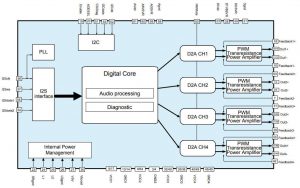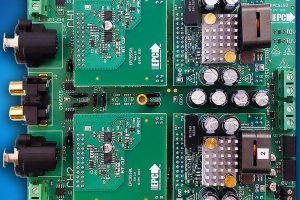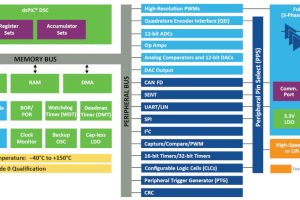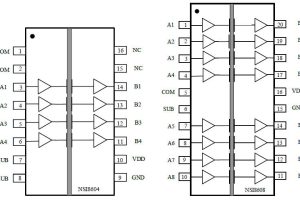
High quality sound is claimed by the company: “With a signal-to-noise ratio of 121dB, 120dB dynamic range and only 10μV output noise, the HFDA801A delivers an extraordinary level of audio performance.”
Distortion is typically 0.02% at 1W 1kHz into 4Ω or 2Ω, or 0.08% across 20 – 20kHz into the same loads. Response can be flat to 80kHz.
Typical output options, as output headroom begins to dominate distortion, are:
- 4 x 30W into 4Ω at 14.4V with 10% THD at 1kHz
- 4 x 25W into 4Ω at 14.4V with 1% THD at 1kHz
- 4 x 50W into 2Ω at 14.4V with 10% THD at 1kHz
- 4 x 80W into 4Ω at 25V with 10% THD at 1kHz
The output LC filter is included in the feedback loop to iron-out the characteristics of the demodulation circuit. “Regardless of the big phase shifting introduced by the output filter, the device shows an adequate phase margin for any load condition,” according to ST. “The system stability has been designed considering: PWM switching variation from 2.1 to 2.3MHz, silicon temperature variation from -40 to 150°C, load variation – inductive and capacitive, LC demodulator filter variation and supply voltage variation. The feedback topology assures a strong control of voltage and current across the load making the diagnostic load detection reliable. Moreover, this topology allows to reach exceptionally good values of output damping factor.” Phase margin is guaranteed >45° for “any working condition”.
Minimum supply voltage is 4.5V, although this is operating and it has to be 5V or greater to power-up. Maximum supply voltage is a bit of a mystery: twice in the data brief (no public data sheet) and once in an external document, ST describes maximum operating voltage as 2,518V, which seems unlikely – Electronics Weekly has asked for clarification.
Abs max is 32V, or 40V for 100ms for load-dump protection. The architecture derives all required voltages internally, enabling the chip to draw its supply from the vehicle battery without the need for additional power converters.
I2S and TDM digital input (up to 16 CH TDM) are available with input sample rate selectable across 44.1, 48, 96 or 192kHz.
In-play diagnostics are integrated as well as a digital impedance meter and real-time load-current monitor – allowing the chip to be used in safety-related audio applications that must demonstrate ASIL compliance, such as acoustic vehicle alerting systems (AVAS).
Packaging is 10 x 10 x 1.4mm exposed pad LQFP64.
The HFDA801A product page is here. It is sampling now and production is planned in the second half of 2021.
 Electronics Weekly Electronics Design & Components Tech News
Electronics Weekly Electronics Design & Components Tech News



re:”Supply voltage is a bit of a mystery: minimum is 4.5V, although this is operating and for turn-on it has to be 5V or greater”.
Just a guess… this might be related to the need to operate (i.e. keep the logic running) during engine cranking. This guess is based on analogous experience with earth moving machines, and you’d need to find someone familiar with automotive standards to have more confidence.
Editor’s note: Mea culpa, my wording in the article was poor and has now been improved. I meant the mystery to apply to the oddly-specified upper working voltage.
Good morning Mr Kurt
Apologies to you: I realised I failed a bit in my wording there and have improved it now (I claim!), the mystery was over the maximum operating voltage.
The information I got did indeed mention cranking for the low voltage end, so you are spot-on 🙂
I wonder if it would not be fairer for the poor battery if the sound system stopped at about 8V, as anything below that means something important is desperately in need of power. Interesting chip, I thought. I can remember when folks were wondering how to get the output filter inside the DAC loop, now quite a few companies are doing it – the control theory gurus have waived their wands.
Indeed, as you correctly say, the control theory gurus have waived their wands, and done the hard yards of maths and analysis 🙂